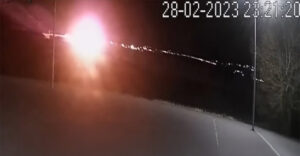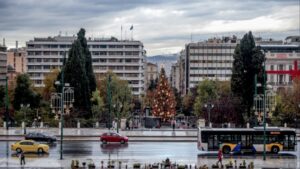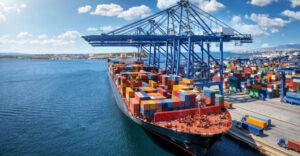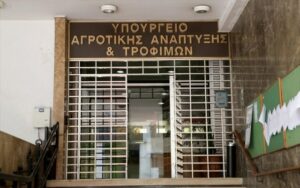The parties involved in the reports on the train collision in Tempi are now shifting their stance: notably, the University of Ghent—which had even calculated the amount of flammable material that caused the fireball at 2.5 tons—issued a statement emphasizing its disagreement with EODASAAM and distancing itself from its report.
What is even more interesting, as revealed today by protothema.gr, is that there were strong disagreements within EODASAAM itself regarding the report’s conclusions on the cause of the fireball, which referred to the “presence of an unknown fuel,” estimated at around 2.5 tons—an assertion now refuted even by the University of Ghent.
At the same time, it has become clear that there were governmental missteps on the matter. Just days before the release of video footage showing the freight train shortly before the tragic accident—which rules out any scenario involving the transport of illegal, flammable materials—the Prime Minister himself appeared, stating that he was not ruling out any possibility regarding the formation of the fireball following the train collision in Tempi.
The Foreign Experts
The official report was presented at a press conference on 27/02, one day before the large demonstrations and the two-year anniversary of the railway tragedy. The day before, on 26/02 at 09:00 a.m., the plenary session of the Board of Directors convened at the offices of EODASAAM in Nea Filadelfeia together with the Investigation Committee—consisting of Bart Accou, the number two official at the European Union Agency for Railways, his associate Fabrizio Carpinelli, and Kostas Kapetanidis, associate of EODASAAM.
At that session, according to the minutes of the Board, which protothema.gr has in its possession, it was requested that the conclusions regarding how the fireball was caused not be announced at the following day’s press conference.
The minutes of the meeting characteristically state: “According to the Board, in any report, the entire investigation, analysis, conclusions, and safety recommendations must be based on valid data, facts, and acts that are indisputable, in accordance with the rules of conducting an independent investigation, and not on assumptions or unproven facts. In this particular case, the simulation was conducted with the participation of individuals who are directly involved in the investigation of the accident in another capacity and, consequently, issues of credibility and validity of the results may be raised. Moreover, the Board emphasized that it was not informed about the use of these individuals in the investigation of the fireball, as no such notification had been made to the Board as was required.” Essentially, the Board refers to the fact that EDAPO, a member of which is mechanical engineer Kostas Lakafosis—who is under scrutiny regarding the accuracy of his statements—was involved, while it is a fact that EODASAAM never contracted the experts of EDAPO.
Do Not Disclose the Report
The continuation of the meeting’s minutes is even more revealing regarding the haste of some to adopt the highly questionable report of Ghent University, which appears to have been based on EDAPO’s models and calculations.
“In light of the above, and because the report of the National Technical University of Athens, specifically that of Professor Karonis regarding the causes of the fireball, is still expected, as well as the authentication of the video footage of 63503 by the forensic laboratories of the Greek police, all members of the Board unanimously requested Mr. Accou and the other two members of the investigation committee (Kapetanidis-Carpinelli) not to disclose the conclusion of the report chapter referring to the causes of the fireball (but only the actions taken to investigate the incident). Specifically, they requested that the result of the simulation—which concludes the presence of at least 2.5 tons of flammable material unrelated to the engines or the declared cargo—be confirmed by a top foreign academic institution, such as the University of Lausanne,” the document specifically states.
What happened during the meeting? Naturally, the Committee members refused to delay the publication of the report. “Respecting the complete independence of the Investigation Committee and the regulations of EDAPP, which are applied analogously as EODASAAM’s operating rules until the adoption of new regulations, the Board members unanimously decided to approve the report, but at the same time authorized the President of the railway sector to immediately initiate the necessary procedures so that a top university in Greece or abroad, such as the University of Lausanne, could draw conclusions regarding the causes of the fireball. Once this research is completed, the Board will proceed with publishing the results and, if its conclusions differ from those reached by the Investigation Committee, a supplementary report will be issued for the specific chapter,” it states.
Papadimitriou vs. Lakafosis
Also highly revealing are the minutes from the EODASAAM meeting held on April 1st.
In that session, the Deputy President of the Organization and head of the railway sector, Christos Papadimitriou, fundamentally challenges EDAPO’s involvement in drafting the report in collaboration with Ghent University and states that the Board of the Organization had not been informed about this in advance, while he also refers to conflicts of interest that arise.
“(The Board) was also informed that the use of EDAPO by the investigation committee for the calculation of the fireball and the collaboration with the University of Ghent was erroneous and in any case irregular, as a) EDAPO represents victims’ relatives, b) it does not have the required authority, and c) the Board was never informed about EDAPO’s role, only learning about it after the fact! It was also informed that the president of the railway sector had formally requested the committee members to submit written evidence regarding when they were informed of the above matter—something that did not occur, as no such official communication was ever made, in complete violation of EODASAAM’s rules,” the statement reads.
And immediately afterward, things get even more interesting. “It was also disclosed that Mr. Papadimitriou was surprised to learn—after the presentation of the report—that the EDAPO simulations had never been submitted to EODASAAM, only their results! Unfortunately, the committee did not even have the decency to officially request those results,” it is emphasized. In effect, the Board of EODASAAM was neither informed in advance about EDAPO’s involvement, nor did it ever receive the simulations themselves, on which the University of Ghent based its assessment.
New Studies
According to information from protothema.gr, the internal balance of power within EODASAAM is now extremely delicate. In fact, through press releases issued over the weekend, EODASAAM explicitly states that the involvement of the Europeans has now concluded, as the Investigation Committee has completed its term with the publication of the official report. From now on, Mr. Papadimitriou is the one making decisions regarding the further examination of the scientific findings related to the fireball and is currently in discussions with both the Demokritos Research Center and a university research laboratory in Greece, which will proceed with a new investigation over a time frame of 5–6 months.
Ask me anything
Explore related questions





